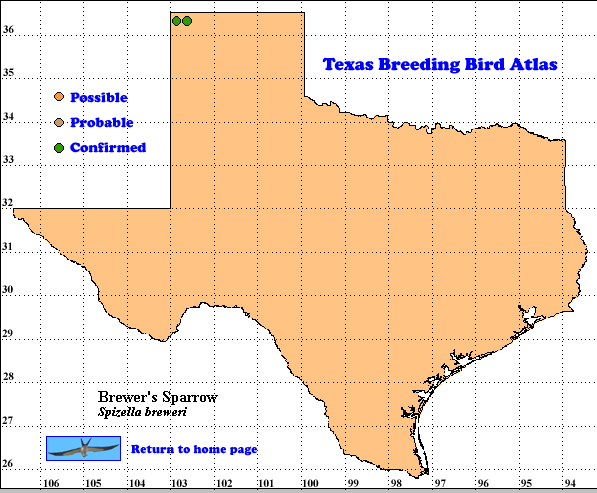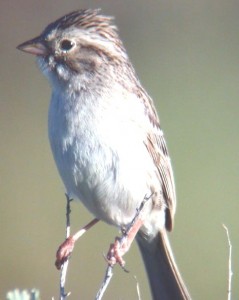The soft, buzzy trills of small groups of Brewer’s Sparrows in late winter indicates these birds are preparing to depart their winter residence for the journey to their breeding ground on sagebrush flats somewhere in the Great Basin of the American West. Singing reaches its highest intensity during the first two weeks after males reach their breeding sites when they are establishing territories and attracting mates. Singing starts before dawn as males perch in shrubs, usually sagebrush, to proclaim the virtues of their territories (Rotenberry et al. 1999, Kroodsma 2005, RCT).
The American Ornithologists’ Union (1998) recognizes 2 groups (subspecies) of this sparrow (S. bl breweri) described in this account and Timberline Sparrow (S. b. taverneri) which breeds high in the Canadian Rockies and the mountains of eastern Alaska Timberline Sparrow differs in appearance, vocalizations, range, breeding habitat and genetics from S. b. breweri and was originally described as a separate species (Doyle 1997, Pyle 1997, Klicka et al.1999, Rotenberry et al. 1999). Some taxonomists consider Timberline Sparrow a distinct species (Monroe and Sibley 1993).
DISTRIBUTION. During the 1987-1992 field work seasons of the TBBA project, volunteers found 2 confirmed and 1 possible breeding sites for Brewer’s Sparrows in latilomg-quads 36102-D6 and D8 in the northwest corner of the Panhandle. These locations are at the edge of the major breeding range of this species extending south from extreme southwest Canada, Washington, Idaho and Montana to eastern California, Nevada, northern Arizona, northern New Mexico and extreme western Oklahoma . Within this area the highest relative abundances (30-100 sparrows per North American Breeding Bird Survey [BBS] route) were found in eastern Oregon, eastern Idaho, northern Nevada and northwest Colorado (Lambeth 1998, Rotenberry et al. 1999, Gall 2004, Mlodinow 2005, Wise-Gervais 2005, Sauer et al. 2007).
These sparrows migrate after the breeding season to winter from southeast California, southern Arizona, southern New Mexico and Trans-Pecos, Texas south through Baja California, Sonora and the central plateau of Mexico. (Howell and Webb 1995, Rotenberry 1999, Lockwood and Freeman (2004).
SEASONAL OCCURRENCE. Brewer’s Sparrows are rare to locally abundant winter visitors to the Trans-Pecos. They are common to uncommon migrants in the western third of Texas from mid-March to latte May and mid-September to early November. In the 19th century these sparrows bred from early May to late June, based on egg collection dates from May 21 to June 12 (Oberholser 1974, Lockwood and Freeman 2004). In Colorado atlasers recorded breeding activity from May 17 to July 31 (Lambeth 1998) and in Arizona from early May to early July (Wise-Gervais 2005).
BREEDING HABITAT. In Texas Brewer’s Sparrows breed from about 900-1200 m (3000-4000 ft) in sagebrush habitat (Oberholser 1974). In nearby Colorado almost 75% of breeding evidence came from big sagebrush (Artemesia tridentata) habitats (Lambeth 1998). In Arizona about 75% of breeding sites were in Great Basin habitats containing sagebrush, blackbrush and shadscale (Wise-Gervais 2005). In eastern Washington at the opposite corner of the range, shrub-steppe habitats, especially with big sage and grasses are preferred for nesting (Mlodinow 2005). Where sagebrush is not available saltbush may be used, sometimes by loose colonies (Harrison 1979).
The female constructs a compact cup of dry grass, forb stems and rootlets, often reinforced with small sagebrush twigs. The lining of fine grass, shreds of sagebrush bark and animal hair completes the construction process which takes 4-5 days for an initial nest or as little as 2 days for a second nest. The nest is usually placed from 17-39 cm (7-16 in) above ground in a sagebrush shrub. Average dimensions are::: outside diameter 8.7 cm (2.5 in), inside diameter 5.2 cm (2 in) and cup depth 4.1 cm (1.6 in; Rotenberry et al. 1999).
In her nest the female usually lays 3 or 4 (range 2-5) bluish-green eggs, marked with dark brown dots or blotches. The eggs are indistinguishable from those of Chipping (S. passerina) and Clay-colored (S. pallida) sparrows. They hatch after 10-12 days of incubation, primarily by the female. Most young leave the nest 6-8 days after hatching, unable to fly. After several days of feeding by the parents, the young grow enough for their wings to support them. Brood parasitism by Brown-headed Cowbirds (Molothrus ater) varies widely, due to habitat differences (Harrison 1979, Rotenberry et al. 1999).
STATUS. Breeding records of Brewer’s Sparrow are rare and infrequent in the Texas Panhandle and adjacent areas of New Mexico and Oklahoma. The most recent records of breeding before the TBBA project, come from these latter states in the 1950s (Oberholser 1974, Gall 2004), not surprising concerning these area lie at the very edge of the breeding range. Fortunately for Texas birders this species is present in the state at other seasons of the year (Lockwood and Freeman 2004). Text by Robert C. Tweit (2008)
 Literature cited.
Literature cited.
American Ornithologists’ Union. 1998. Checklist of North American birds, 7th ed. Am, Ornithol. Union. Washington, DC.
Doyle, T. J. 1997. The Timberline Sparrow, Spizella (breweri) taverneri,with notes on breeding habitat and vocalizations. West. Birds 28: 1-12.
Gall, B. L. 2004. Brewer’s Sparrow (Spizella breweri). In Oklahoma breeding bird atlas, pp. 402-403 (D.L. Reinking, ed.). Oklahoma University Press, Norman.
Harrison, H. H. 1979. A field guide to western birds’ nests. Houghton Mifflin, Boston, MA.
Howell, S. N. G. and S. Webb. 1995. A guide to the birds of Mexico and northern Central America. Oxford University Press, New York.
Kroodsma, D. 2005. The singing life of birds. Houghton Mifflin, Boston, MA.
Lambeth, R. 1998. Brewer’s Sparrow (Spizella breweri). In Colorado breeding bird atlas, pp. 456-457 (H. E. Kingery, ed.). Colorado Bird Atlas Partnership, Denver.
Lockwood, M. W. and B. Freeman. 2004. The TOS handbook of Texas birds. Texas A&M University Press, College Station.
Mlodinow, S. G. 2005. Brewer’s Sparrow (Spizella breweri). In Birds of Washington, pp. 325-326 (T. R. Wahl, B. Tweit and S. G. Mlodinow, eds.). Oregon State University Press, Corvallis.
Monroe, B. L., Jr. and C. G. Sibley. 1993. A world checklist of birds, Yale University Press, New Haven, Ct.
Oberholser, H. C. 1974. The bird life of Texas. University of Texas Press, Austin.
Pyle, P. 1997. Identification guide to North American birds, part 1. Slate Creek Press, Bolinas, CA.
Rotenberry, J. T., M. A. Patten and K. L. Preston. 1999. Brewer’s Sparrow (Spizella breweri). In The birds of North America, No. 390 (A. Poole and F. Gill, eds.). The Birds of North America, Inc., Philadelphia, PA.
Sauer, J. R., J. E. Hines, and J. Fallon. 2007. The North American breeding bird survey, results and analysis 1966-2006. Version 7.23.2007. USGS Patuxent Wildlife Research Center, Laurel MD < http://www.mbr-pwrc.usgs.gov/bbs>
Wise-Gervais, C. 2005. Brewer’s Sparrow (Spizella breweri). In Arizona breeding bird atlas. pp. 514-515 (T. E. Corman and C. Wise-Gervais, eds.). University of New Mexico Press, Albuquerque.
